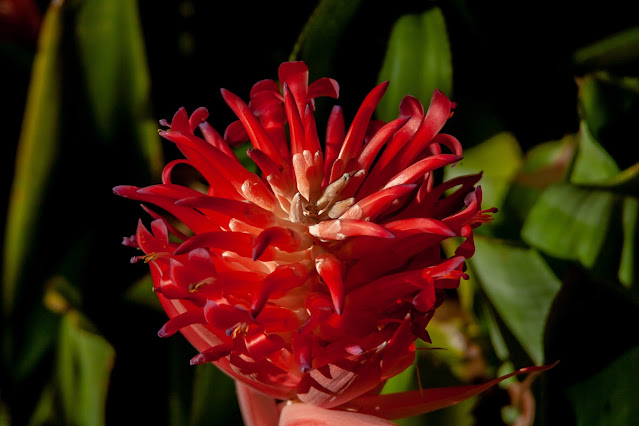Billbergia bromeliads are captivating plants known for their striking foliage and vibrant, long-lasting flowers. Belonging to the Bromeliaceae family, which includes pineapples and Spanish moss, Billbergias are native to the tropical regions of Central and South America. These plants are favored by many enthusiasts for their relatively easy care requirements and their ability to thrive indoors or outdoors in various climates. In this comprehensive guide, we will delve into everything you need to know to successfully grow and care for Billbergia bromeliads.
Understanding Billbergia Bromeliads:
- Billbergia bromeliads are characterized by their rosette-shaped foliage, which forms a central cup or tank where water collects.
- The leaves of Billbergias are typically tough and leathery, often with serrated edges, and can vary in color from green to reddish-purple, depending on the species and cultivar.
- One of the most appealing features of Billbergia bromeliads is their inflorescence, which emerges from the central cup and produces vibrant flowers in shades of pink, purple, red, or yellow.
- Unlike some other bromeliad species, Billbergias are epiphytic, meaning they naturally grow on other plants or trees rather than in soil. However, they can also be grown in pots or containers filled with a suitable potting mix.
Growing Conditions:
- Light: Billbergia bromeliads prefer bright, indirect light. They can tolerate some direct sunlight, especially during the morning hours, but prolonged exposure to intense sunlight may cause their leaves to burn.
- Temperature: These plants thrive in warm temperatures ranging from 60°F to 80°F (15°C to 27°C). Avoid exposing them to temperatures below 50°F (10°C), as they are sensitive to cold.
- Humidity: Billbergias appreciate moderate to high humidity levels. If you're growing them indoors, consider using a humidifier or placing a tray filled with water and pebbles beneath the plant to increase humidity.
- Air Circulation: Adequate air circulation is essential for preventing fungal diseases and promoting overall plant health. Ensure good ventilation, especially in indoor environments.
Potting Mix and Containers:
- When selecting a potting mix for Billbergia bromeliads, choose a well-draining medium that mimics their natural epiphytic habitat. A blend of orchid bark, perlite, and peat moss works well.
- Plant Billbergias in shallow containers or pots with drainage holes to prevent water from accumulating around the roots.
- If you prefer to mount Billbergias on a piece of driftwood or tree bark, use sphagnum moss or a specialized bromeliad mounting mix to secure the plant in place.
Watering:
- Watering Billbergia bromeliads is relatively straightforward. Fill the central cup of the plant with water, ensuring it remains consistently moist but not waterlogged.
- It's essential to use filtered or rainwater when watering Billbergias, as they are sensitive to chemicals and salts found in tap water.
- Empty and refill the central cup with fresh water regularly to prevent stagnation and the growth of algae or mosquitoes.
- In addition to watering the central cup, occasionally mist the leaves of the plant to increase humidity and remove dust.
Feeding and Fertilization:
- Billbergia bromeliads are light feeders compared to some other plants. Use a balanced, water-soluble fertilizer diluted to half or quarter strength and apply it to the central cup or soil during the growing season (spring and summer).
- Avoid fertilizing Billbergias during the dormant period in fall and winter, as they require less nutrients during this time.
- Alternatively, you can use a specialized bromeliad fertilizer formulated specifically for epiphytic plants, following the manufacturer's recommendations for application.
Pruning and Maintenance:
- Pruning Billbergia bromeliads is generally minimal and involves removing any dead or damaged leaves to maintain the plant's appearance and health.
- Use clean, sharp pruning shears to make clean cuts, and avoid damaging the central cup or crown of the plant.
- Remove spent flowers promptly to redirect the plant's energy back into foliage growth or the development of new pups (offsets).
Propagation:
- Billbergia bromeliads propagate readily through offsets, also known as pups, which emerge from the base of the parent plant.
- Once the pups are large enough to handle, carefully separate them from the mother plant using a sharp knife or scissors, ensuring each pup has its own roots attached.
- Plant the pups in a small container filled with a suitable potting mix, and provide them with the same care as mature plants.
Common Pests and Diseases:
- While Billbergia bromeliads are relatively resistant to pests and diseases, they may occasionally encounter issues such as mealybugs, scale insects, or fungal infections.
- Inspect your plants regularly for signs of pests or disease, such as yellowing leaves, distorted growth, or the presence of insects.
- Treat any infestations promptly with insecticidal soap or horticultural oil, and isolate affected plants to prevent the spread of pests.
- Avoid overwatering, as this can lead to root rot and other fungal problems. Ensure proper drainage and allow the soil or potting mix to dry out slightly between waterings.
With their stunning foliage, long-lasting flowers, and relatively low-maintenance requirements, Billbergia bromeliads are excellent additions to any indoor or outdoor garden. By providing them with the right growing conditions, proper care, and attention to detail, you can enjoy these unique plants for years to come. Experiment with different species and cultivars to discover the diversity and beauty of the Billbergia genus. Happy growing!

